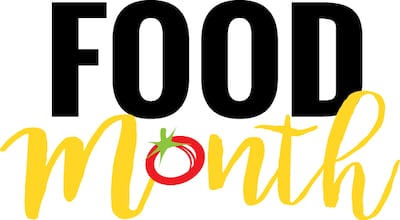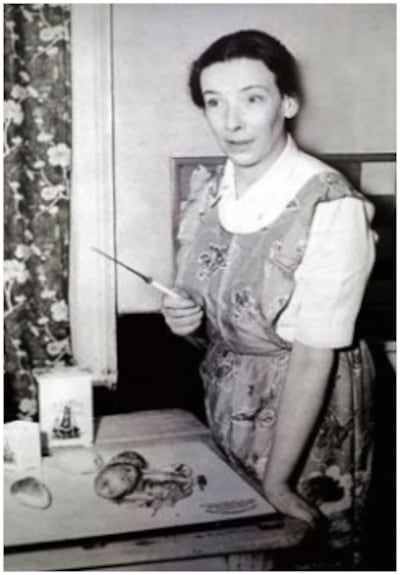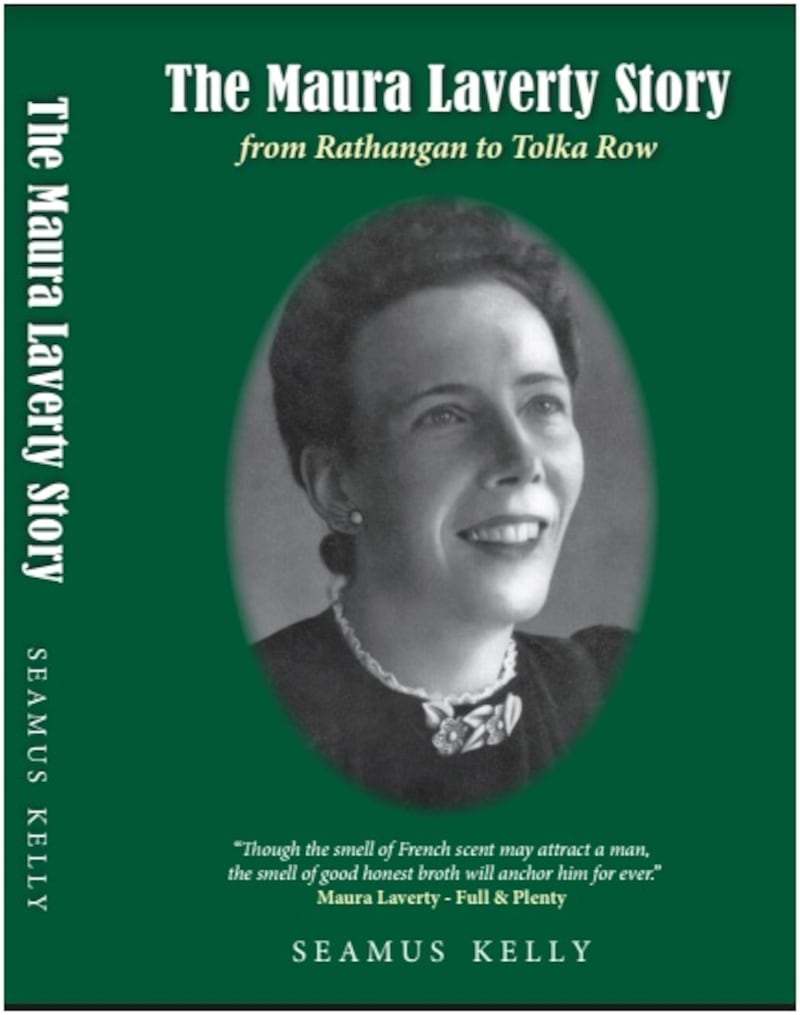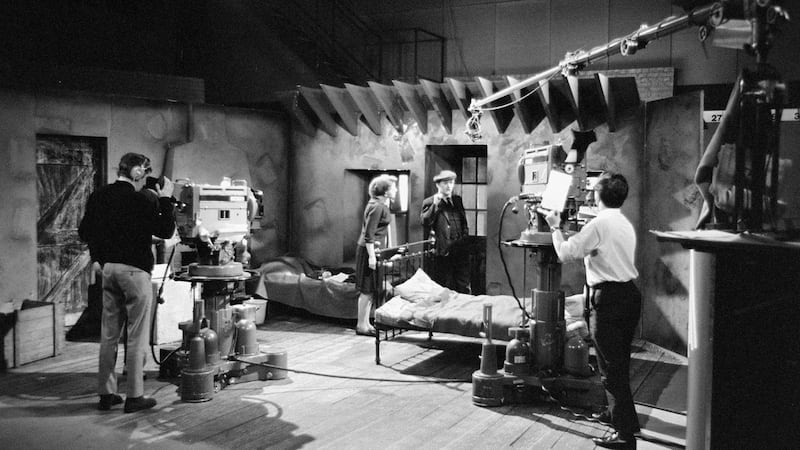The cover picture of The Story of Maura Laverty is one of my favourite photographs of Maura, taken in 1946 at the height of her literary prowess and when she was president of the Women Writers’ Club. It appeared in the Irish Press in January 1946. It also was in The Bell magazine in January 1946. The cover design is by Sinead O’Kelly, a relative of Maura who lives in Kilkenny.

Maura Laverty was an Irish novelist, storyteller, poet, journalist, scriptwriter, playwright, broadcaster, advice columnist and cookery book writer. She was also a daughter, sister, wife, mother and grandmother. She had a wide circle of friends and professional colleagues; some of them were very well-known in the worlds of journalism, cookery, fiction, theatre, radio and television. We have to bear in mind that Maura died quite young, in 1966, at the age of 59.
The book documents the life and work of Rathangan’s Maura Laverty (née Kelly) from her youth to her writing of Full and Plenty and Tolka Row in the 1960s.
Part of my motivation for writing the book is that I am from Rathangan, Co Kildare, the place of Maura’s birth, of her primary schooling, and of her marriage. How Maura is and was remembered, both positively and negatively, in her home village is an important theme that is fully explored here for the first time.
My immediate aim was simple. It was to produce the best book that I could on Maura Laverty. It was not an easy task, but I found the story fascinating. I hope others will too. Laverty was a household name in Ireland, perhaps from the 1930s, and certainly from the 1940s to the mid-1960s. Most Irish people over 60 have heard of her. Some mix her up with the writer Mary Lavin.

Maura is often referred to as the “Mammy of Irish cookery”. Her cookery book writing culminated in the 500-page Full and Plenty (1960). This much loved and much used work has an assured place in the history of Irish cookery writing. It is indeed a well-thumbed collector’s item. Her cookery advice and recipes were “the poetry of housework”, not just for herself but for so many of her loyal fans. She provided a version, Feasting Galore, for her many fans in America.
Many people have inherited the family copy of Full and Plenty. Alison Healy reflected in the Irish Times last November on her copy. “It sits with the other cookbooks in my kitchen but it does not look like them. It doesn’t have glossy photographs to illustrate every recipe. The layout is dull: with several recipes squashed into every page but it’s the best-thumbed cookbook of the lot. This is the 1960 edition of Maura Laverty’s Full and Plenty, the one with the blue and yellow cover. It belongs to my mother.” Healy confirmsed “it was a repository for things she wanted to keep”. I discovered my Dad’s recipes for elderberry wine and Mam’s for home-made jam in our copy.

Regarding Maura’s status in comparison to other female Irish writers of her era, the prevailing view is that she was a very good and popular storyteller but not as good a novelist as Kate O’Brien or Molly Keane, nor as good a short story writer as Mary Lavin, nor as good or as prolific a children’s writer as Patricia Lynch. Few Irish female writers of the past were in the same league as that talented lot. Maura was probably as good a cookery writer and broadcaster as Monica Sheridan, though Monica made her breakthrough on TV, despite licking her fingers on air. Maura was a forerunner of gossip columnist Angela MacNamara and agony aunt Frankie Byrne and of many food writers. She was also a poet, especially in her youth.
Laverty was the most versatile female Irish writer between 1940 and the mid-1960s. Her varied work was very popular. She is a storyteller of note whose own story has not been told. A self-made woman, she earned her living for more than 35 years by writing and broadcasting. Even today, not many manage that.
Her story needs telling, and now is the time to tell it. Maura did not write an autobiography, though three of her four novels are very autobiographical. There is no biography of this versatile and talented writer, but there are many newspaper articles and reviews, an excellent RTÉ radio documentary by Sarah Binchy (2011), many, many of her stories, and a good deal of academic commentary in relation to Maura and her literary work. My book explores the complex relationship between the real Maura and her fiction writing and broadcasting. It brings the strands of previous writing and earlier research together and makes a number of new discoveries in relation to Maura, her work and her family.
Maura was a very good storyteller. Sean O’Faolain, in the preface of Maura’s first novel Never No More, emphasised that she “had a remembering eye keen enough and a heart warm enough to have plenty to tell that we enjoy hearing, and the skill to tell it”. He was encouraging, but concerned, that she would not push on with more writing. “If Maura Laverty does not follow up this first book with a set of novels about the crowded world of her childhood she is simply throwing away a store of wealth that any writer will envy…” He need not have worried. She was already addicted to being published, and she fed that impulse regularly.

As well as being a mother of three children – Maeve, Barry and James – Maura was a professional writer and broadcaster. Her 35 years of radio broadcasting helped to make her a household name. Her ESB-sponsored radio programme lasted for 11 years until her untimely death in 1966. Apart from her four novels, she wrote three successful plays for the professional stage and five cookery books. She also wrote children’s books, most notably Cottage in the Bog.
Dr Caitriona Clear has highlighted her work for women’s magazines. She wrote regularly in Woman’s Way in 1963. She was also a main writer for Woman’s Life magazine in the 1930s. Publishing short romantic stories widely was her forte along with her radio work. She wrote at least five stories for the US magazine Woman’s Day in the 1950s which had a huge circulation. She also wrote several stories for Sean O’Faolain’s influential Bell magazine in the early 1940s, which was important for her profile in writing circles. The story Proud Woman, for example, appeared in The Bell in 1942 and reappeared many times after that. Maura recycled her stories at every opportunity.
She published extensively in the Passionists’ Sign magazine in America and she had much stronger American connections, both family and professional, than known hitherto. Four grandchildren still live there. She also published several stories in Australia in the 1930s and the 1950s.
She even wrote propaganda for Clann na Poblachta in 1947 and 1948 and served on its national executive for a short period.
Let us be proud of an Irish woman writer who wrote and told many a good story
Maura Kelly married Seamus Laverty in Rathangan at the age of 21 in 1928. They raised three children. Maura’s first child, Maeve, was born in 1931, Barry (a girl) in 1935 and her last child James in 1948. Barry later became Barry Castle, the well-known artist. Maura was a very good provider for her children, and she gave them educational opportunities.
Maura’s wedding is recorded in the Rathangan church records and was covered by the Leinster Leader. Seamus was a PT instructor with the Free State Army. He had enlisted in 1925 and rose to the rank of company sergeant. He left his steady army job in 1929 for the more uncertain world of journalism and broadcasting. He was later a sports broadcaster, a journalist, and a sub-editor in Dublin and Belfast.
Maura is remembered fondly by many, and forgotten by many more. She was born in Kildare to Kilkenny parents, was raised in Rathangan, then went to boarding school in Tullow, Co Carlow, before heading off for Spain for four years (1924-1928) at the age of 17 to work as a governess.
After she married, she spent the rest of her life in Dublin raising her family, working in broadcasting, mingling in literary circles and writing.
Maura above all wanted to be known and remembered as a creative writer. She was a wonderful describer of people, food and places. She could be harsh in her descriptions of people, especially in terms of their physical appearance. The fact that they could be quite easily identified did her reputation some serious damage in her home village, but not nationally or internationally. Never No More (1942), her first novel, caused quite of stir in Rathangan because people knew, or thought they knew, who she was writing about and many were less than impressed. The passage of time is a great healer. Today, Rathangan honours her memory with an attractive monument.
She wasn’t the most technically gifted novelist. As Kate O’Brien rightly said, “she remembered more than she imagined”. Maura, nevertheless, reflected insightfully on her own youthful experiences and the people she met. She captured very well the place in which she grew up and her time in Spain to produce three of her four novels. She spent some time as a child, all of her married life, and the rest of her adult life in Dublin. The Dublin-based novel Liffey Lane is the least autobiographical of her novels and it led on to Tolka Row, the play, the movie and the TV series. This well-liked and remembered programme was her greatest achievement.
The early 1950s was her playwriting phase where she worked with the Hilton Edwards-Micheal MacLíammóir partnership and their impressive entourage of actors. The duo, however, had a tendency to stall on her royalties.

Maura rarely missed an opportunity to be published but she had the great advantage of not being a one-trick pony. Rural, nostalgic novels were “in” in the 1940s and she was supplied them. So too with rural children’s stories. Women, with a mind of their own, were co-operating in the Women Writers’ Club in the 1940s in order to get heard and to get read. Maura was in the midst of that too. Urban plays and the start of Irish TV were an integral part of the 1950s and 1960s literary Dublin scene and she was intimately involved. Her Tolka Row success was well earned. It was first aired in January 1964, and kept her going, along with her ongoing radio work, until her untimely death in July 1966.
It took Maura more than 30 years of broadcasting and writing to get her big breaks with Tolka Row and Full and Plenty. Along with these successes came some financial stability. It is a pity that this great opportunity did not come earlier for Maura when she had more energy for it. Her last years and days were spent living alone in her own house in Rathfarnham, Dublin. The one thing people ask all the time, when you are retired like me, is are you enjoying it? Maura did not get a chance to enjoy her retirement and was denied the energy, time and space to complete a memoir.
Maura lived through six decades, ones of hardship for many families. Life was often a struggle for her and many more besides. Ireland was not a land of Full and Plenty in those decades.
Searching for evidence about her background, her life and her work has been a rewarding journey. Let us be proud of an Irish woman writer who wrote and told many a good story and told them very well from Rathangan to Tolka Row.
I will finish with a few lines from her banned and least-known novel Alone We Embark (1943) which captures very well Maura’s creative and descriptive powers, her love of romance and her love of writing.
“Beauty lay cold and unresponsive under the chill caress of February.
March did his boisterous best to win her, and she smiled a little through her sleep at his callow wooing.
The pleading tears of April fell on her face and she stirred and wakened, but his moodiness affronted her and she refused him her delights.
Then May bent and fondled her with love and then she knew it was for him she was waiting. She gave a long sigh of wonder.
The people of Tullynawlin felt that sigh on their faces.”
The Story of Maura Laverty: from Rathangan to Tolka Row is being launched on Sunday, November 19th, at 2.30pm in the Community Centre, Rathangan, Co Kildare. All are welcome. It will then be available in shops and directly from the author. Enquiries to james.a.kelly55@gmail.com










